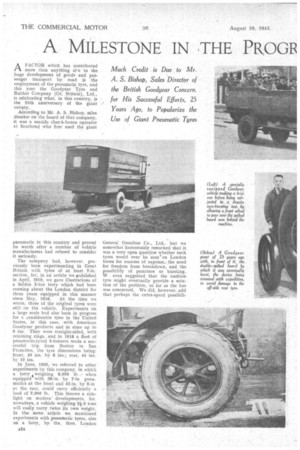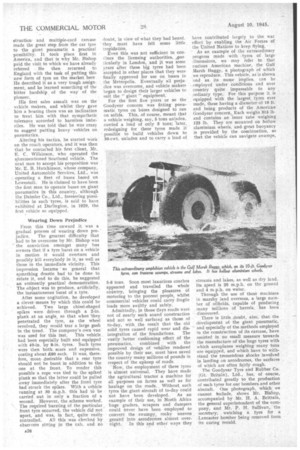A MILESTONE IN THE PROGR OF THE GIAN PNEUMATIC
Page 26

Page 27

Page 28

If you've noticed an error in this article please click here to report it so we can fix it.
P-1 A FACTOR which has contributed more than anything el-e to the huge development of goods and passenger transport by road is the employment of the pneumatic tyre, and this year the Goodyear Tyre and Rubber Company (Gt. Britain), Ltd., is celebrating what, in this country, is the 25th anniversary of the giant variety.
According to Mr. A. S. Bishop, sales director on the board of that company, it was a seaside char-à-bancs operator at Southend who first used the giant pneumatic in this country and proved its worth after a number of vehicle manufacturers had refused to consider it seriously.
The company had, however, previously been experimenting in Great Britain with tyres of at least 7-in. section,. for, in an article we +published in April, 1919, we gave illustrations of a Selden 2-ton lorry which had been running about the London district for three years equipped in this manner
since May, 1916. At the time we wrote, three of the original tyres were still' on the vehicle. Experiments on a large scale had also been in progress for a considerable time in the United States, in this case, with American Goodyear products and in sizes up to 9 ins. They were straight-sided, with retaining rings, and in 1918 a fleet of pneumatiortyred 5-tonners made a successful trip from Boston to San Francisco, the tyre dimensions being: front, 40 ins. by 8 ins..; rear, 44 ins, by 10 ins.
In June, 1920, we referred to other experiments by this company, in which a lorry ,weighing 8,000 bb when equipped with 38-in. by 7-in pneumatics at the front and 42-in. by 9-in at the rear, could carry efficiently a load of 7,000 lb. This throws a sidelight on modern' developments, for, nowadays, a vehicle weighing 2-1--3 tons will easily carry twice its own weight. In the same article we mentioned experiments with pneumatic tyres, also on a lorry, by the, then, London
General Omnibus Co., Ltd.. but we somewhat humorously remarked that it was a very open question whether such tyres would ever be seen I' on London buses for reasons of expense,. the need for freedom from breakdown, and the possibilify of puncture or bursting. W. even suggested that the cushion tyre might eventually provide a solution of the problem, so far as the bus was concerned. We did, however, add that perhaps the extra-speed possibili
ties of the pneumatic cbuld be utilized in connection with coaches, thereby increasing the comfort as well as the popularity of that type of vehicle.
It will thus be seen that, at that time, we, the manufacturers and many operators, were most dubious regarding the ultimate employment of large pneumatics, particularly so far as buses were concerned, although we were more enthusiastic as to their potentialities in connection with goods vehicles,
pneumatics had ran more than 40,000 miles without once being removed from their rims, and he referred to 'reliable statistics which showed that on 30seater buses large pneumatics averaged over 20,000 miles per set.
Speaking a few days ago, Mr. Bishop said that up to 1920 ordinary pneumatics had been used for cars and light commercial vehicles, but those early tyres were in their infancy and contributed to make motoring hazardous.
In earlier days, when a motorist obtained 3,000 miles from a tyre, he wrote to the Press about it. However, as penumatic tyres were being used extensively on cars, it was only natural to ask why they could not be made larger for heavier vehicles. Without going deeply into technical details, the situation was that the carcases, at that time, were made with a square-woven fabric. Under constant flexing, this material caused them to run very hot and thus set a definite limit to the sizes which could be satisfactorily made. The employment of some improved form of fabric, therefore, became essential, and when this was developed it was known as the multiple cord. Another obstacle in the way of advancement was the tyre bead which, until then, had been • of the clincher type, which had to be stretched over the rim of the wheel. As this was not practicable• for the larger sizes, the Goodyear concern perfected what was known as the straight-sided tyre.
This combination of the new con struction and multiple-cord carcase made the great step from the car tyre to the giant pneumatic a practical possibility. It took place first in America, and that is why Mr. Bishop paid the visit to which we have already referred • He then returned to England with the task of putting this new form of tyre on the market here He described it as a very tough assignment, and he learned something of the bitter hardship of the way of the pioneer.
His first sales assault was on the vehicle makers, and whilst they gave him a hearing there was an inclination to treat him with that sympathetic tolerance accorded to harmless imbeciles. He was told that he was crazy to suggest putting heavy •vehicles on pneumatics.
Altering his tactics, he started work on the coach operators, and it was then that he contacted his first client, Mr. E. C. Wilkinson, who operated the aforementioned Southend vehicle. The next man to accept his proposition was Mr. E. B, Hutchinson, whose company, United Automobile Services, Ltd., was operating a fleet of buses based on Lowestoft. He is claimed to have been the first man to operate buses on giant pneumatics in this country, although the Daimler Co., Ltd., foreseeing possibilities in such tyres, is said to have exhibited at Darlington, in 1920, the first vehicle so equipped.
Wearing Down Prejudice From this time onward it was a gradual process of wearing down pre judice. The greatest difficulty that had to be overcome by Mr. Bishop was the conviction amongst many bus owners that if a tyre burst on a vehicle in motion it would overturn and possibly kill everybody in it, as well as those in the immediate vicinity. This impression became so general that something drastic had to be done to refute it, and to do this, he suggested an eminently practical demonstration. The object was to produce, artificially. the instantaneous burst of a tyre.
After some cogitation, he developed a clever means by which this could be achieved. Two large chisel-shaped spikes were driven through a 2-in. plank at an angle, so that when 'they penetrated the tyre, as the wheel revolved, they would tear a large gash in the tread. The company's own van was used for this test. This vehicle had been especially built and equipped with 40-in. by 8-in. tyres. Such tyres were then both scare and expensive, costing about £80 each. It was, therefore, most desirable that a rear tyre should not be burst in addition to the one at the front. To render this possible a rope was tied to the spiked plank so that the latter could be pulled away immediately after the front tyre had struck the spikes. With a vehicle running at 30 m.p.h. this had to be carried out in only a fraction of a second. However, the scheme worked. The req,uired bursting of the particular front tyre occurred, the vehicle did not upset, and was, in fact, quite easily controlled. All this was checked by observers sitting in the cab, and no doubt, in view of what they "had heard, they must have felt some little trepidation.
Even this was not sufficient to coneince the licensing authorities, warricularly in London, and it was some years after these big tyres had been accepted in other places that they were finally approved for use on buses in the Metropolis. Eventually all prejudice was overcome, and vehicle makers began to design their larger vehicles to suit the "giant " equipment.
For the first five years or so the Goodyear concern was fitting pneumatic tyres on buses designed to run on solids. This, of course, meant that a vehicle weighing, say, 5 tons unladen, carried a load of only 3 tons; later, redesigning for these tyres made it possible to build vehicles down to 50-cwt. unladen and to carry a load of 5-8 tons. Soon most luxurious coaches appeared and travelled the whole country, bringing the pleasures of motoring to the poorest people, whilst commercial vehicles could carry fragile loads more swiftly and safely.
Admittedly, in those days roads were not of nearly such sound construction and not so well surfaced as those of to-day, with the result that the old solid tyres caused rapid wear and dis integration of the foundations. The vastly better cushioning effect of the pneumatics, combined with the improved design of vetales rendered possible by their use, must have saved the country many millions of pounds in respect of the upkeep of roads.
Now, the employment of these tyres is almost universal. They have made the agricultural tractor a machine for all purposes on farms as well as for haulage on the roads. Without, such tyres the giant aircraft of to-day could not have been developed. As anexample of their use, in Nonth Africa huge graders, scrapers and dumpers could never have been employed to convert the swampy, rocky uneven ground into aerodromes almost over
night. In this and other ways they have contributed largely to the war effort by enabling the Air Forces of the United Nations to keep flying. • As an example of the extraordinary progress made with tyres of large :limensions, we may refer to that curious American machine, the Gulf Marsh Buggy, a photograph of which we reproduce. This vehicle, as is shown and as its name implies, can be employed under conditions and over country quite impassable to any ordinary type. For this purpose it is equipped with the largest tyres ever made, these having a diameter of 10 ft. and being products of the American Goodyear concern, Each weighs 315 lb and contains an inner tube weighing 125 lb. They are mounted on hollow aluminium wheels, andgreat buoyancy is provided by the combination, so that the vehicle can navigate swamps.
streams and lakes, as well as dry land. Its speed is 20 m.p.h. on the ground and 4 m.p.h. on water,
Through the use of these machines in marshy land overseas, a large number of oilfields, capable of producing ninny millions of barrels, has been
discovered. • There is little doubt, also, that the development of the giant pneumatic, and e,specially of the methods employed in the construction of its carcase, have assisted in no small measure towards the manufacture of the huge tyres with which aeroplanes weighing many tons are equipped, and which have to withstand the tremendous shocks involved in landing on aerodromes, the surfaces of which are often fairly rough.
The Goodyear Tyre and Rubber Co. (Gt. Britain), Ltd., has, of course, contributed greatly to the production of such tyres for our bombers and other aircraft. One photograph, which we cannot tnclude, shows Mr. Bishop, accompanied bY Mr. II. A. Brittain, the general superintendent of the company, and Mr. P. H. Sullivan, the secretary, watching a tyre for a Lancaiter bomber being removed from its curing mould.




















































